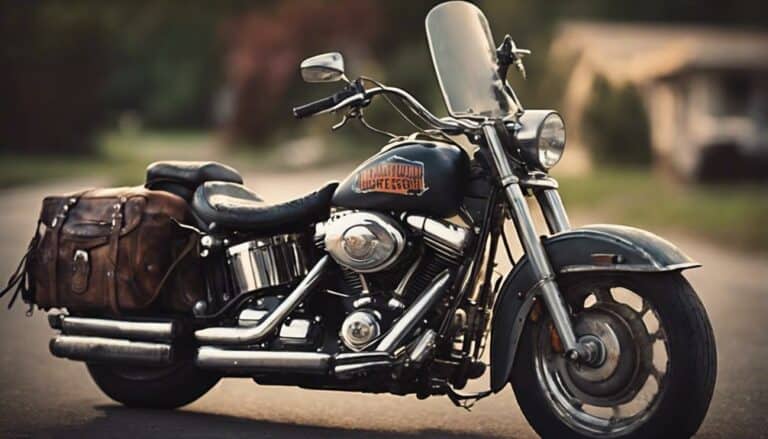You may have heard various claims about the mileage that Harley-Davidson motorcycles can endure, but what truly constitutes high miles for a Harley may surprise you. Understanding the factors that influence a Harley's lifespan is essential for Harley enthusiasts and riders alike.
From engine size to maintenance practices, the discussion around high mileage for a Harley-Davidson unveils intriguing insights that could impact your riding experience and ownership journey.
Stay tuned as we unveil the realities behind Harley-Davidson's longevity and what it means for your beloved bike.
Key Takeaways
- Post-1998 Harley models can reach 80,000-100,000 miles, indicating high mileage potential.
- Proper maintenance significantly impacts the longevity of Harley Davidson engines.
- Evolution 883cc vs. Milwaukee-Eight 107 engines have varying mileage capabilities.
- Terrain conditions and riding style affect the overall lifespan of a Harley Davidson.
Factors Affecting Harley Davidson Mileage
Factors impacting the mileage of a Harley Davidson motorcycle range from your riding style to the overall condition of the bike. How you treat your Harley, including the frequency of use and the terrain you navigate, plays a pivotal role in determining its gas mileage.
Aggressive riding, high speeds, and pushing the engine to its limits can result in increased wear and tear, potentially leading to the engines being worn out sooner than expected. The Evolution 883cc engine, for instance, tends to clock fewer miles before showing signs of fatigue compared to the more robust Milwaukee-Eight 107 engine.
Regular maintenance isn't just a suggestion but a necessity if you aim to squeeze the maximum mileage out of your Harley Davidson. Ensuring your motorcycle is in top-notch shape won't only enhance its longevity but also optimize its gas mileage, allowing you to enjoy the freedom of the open road for longer stretches.
Longevity of Harley Davidson Engines
Harley Davidson engines demonstrate remarkable longevity, often surpassing 80,000 to 100,000 miles without significant wear post-1998 models. The lifespan of a Harley Davidson engine can be influenced by various factors, including proper maintenance, riding style, and terrain conditions.
Here are key points to consider regarding the longevity of Harley Davidson engines:
- Post-1998 models can typically reach 80,000 to 100,000 miles with proper maintenance.
- The Evolution 883cc engine may have a shorter lifespan compared to the Milwaukee-Eight 107 engine due to differences in design and performance.
- Factors such as off-road riding or harsh terrain can impact engine wear and reduce the overall mileage potential of a Harley Davidson motorcycle.
Harley Davidson Maintenance Tips
Regularly checking and maintaining oil levels is crucial for ensuring optimal engine health and performance on your Harley Davidson. Schedule routine oil changes to keep your engine running smoothly and to extend its lifespan.
Remember to monitor and replace the oil filter as needed to maintain proper filtration and protect your engine from contaminants.
Additionally, staying on top of air filter maintenance is essential; replace dirty filters regularly to ensure efficient engine operation.
Don't overlook the importance of tire condition in your Harley Davidson maintenance routine. Keeping your tires in good shape is vital for both performance and safety while riding.
Service Milestones for Harley Davidsons
When maintaining your Harley Davidson, adhere to service milestones at specific mileage intervals for optimal performance and longevity. Following a structured maintenance schedule is crucial to ensure the reliability of your bike.
Here are some critical milestones to keep in mind:
- 5,000 Miles:
- Replace engine oil.
- Inspect the brake system.
- 10,000 Miles:
- Perform battery care.
- Change the oil filter.
- Inspect the brake system.
- 30,000 Miles:
- Check tires for wear.
- Inspect brake components.
- Ensure all fluids are at the proper levels.
Adhering to these service intervals is imperative for the longevity of your Harley Davidson. At 50,000 miles, consider fork disassembly and inspection to maintain optimal performance.
Extending the Lifespan of Your Harley
To maximize the longevity of your Harley Davidson, meticulous attention to maintenance and adherence to manufacturer-recommended schedules are essential. Take a closer look at your service manual and ensure that you're keeping up with the maintenance milestones.
Regular service intervals are crucial to keeping your bike running smoothly and preventing any potential issues. Make sure to use high-quality oil and lubricants as they play a significant role in extending the lifespan of your Harley. Synthetic oils, in particular, can contribute to longer engine life and help maintain optimal performance.
Keeping your bike properly stored and cared for during off-seasons is another important aspect of extending its lifespan. By taking care of your Harley Davidson through regular maintenance, using quality products, and ensuring proper storage, you can enjoy many more miles on the road with your beloved bike.
Conclusion
You've learned that high mileage for a Harley-Davidson varies based on model and maintenance. With proper care, smaller bikes can easily reach 20,000 to 30,000 miles, while larger models can surpass 30,000 to 50,000 miles.
Remember, vintage Harleys with meticulous upkeep have been known to go even further. So, keep up with routine maintenance and your Harley could last a lifetime, defying the odds like a steel horse that never tires.

